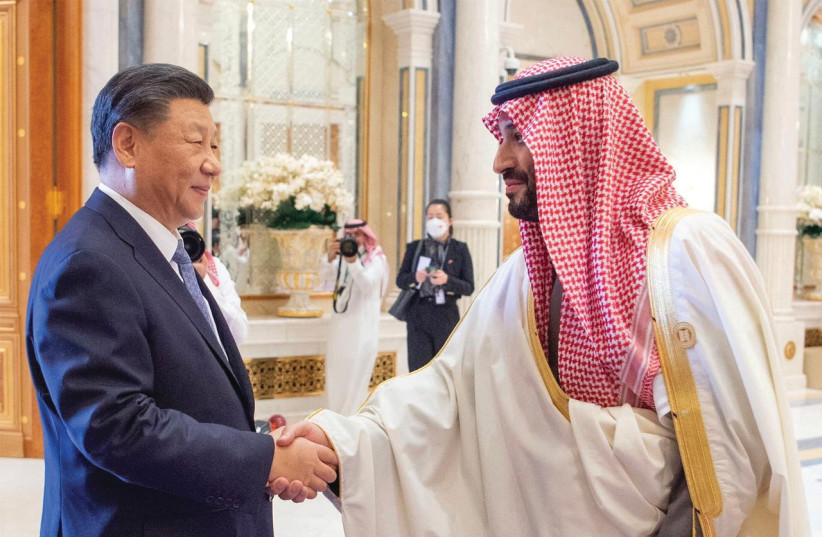Around the visit of the President of the People’s Republic of China, Xi Jinping, to Saudi Arabia this past month, there has been growing speculation over whether his arrival symbolized the end of the US era in the Persian Gulf, heralding the start of a new period of Chinese dominance instead.
The Middle East has witnessed a “changing of the guard” in the past, with the Portuguese, under Admiral Albuquerque conquering the Gulf region. The British Empire then took over, which in turn lost its standing to the US Navy after World War II.
China has shown signs of moving in, as the US has indicated its desire to reduce its influence in the Middle East, according to a growing school of thought. Harvard professor, Graham Allison wrote a book five years ago, titled Destined for War: America & China. He referred to China as a “rising power” and the US as a “ruling power.”
A few years earlier, the Obama administration raised the idea of an American “pivot” of power from Europe – including the Middle East – to Asia.

China is the world's rising power
One article after another hinted at this possibility. In 2017, Popular Science published a piece about China’s latest aircraft carrier, in which it was suggested that Beijing had “a powerful navy in the works.” Between 2015 and 2020, China also crossed an important naval threshold when its battleships forged ahead of the US Navy’s battleships.
In terms of ship construction, China assembled the world’s largest navy during this period. This year, it also launched a third aircraft carrier, Fujian, named after the Chinese province that sits directly across from Taiwan. Plans were also unveiled for a fourth carrier.
The US Congressional Research Service released an updated report on December 1 2022. In it, the implications of China’s Naval Modernization programs were reviewed. It concluded that, besides achieving a greater degree of domination over its region in the South China Sea, China is also seeking to extend the range of its naval presence in areas of interest in the Pacific, focusing on the defense of its “sea lines of communication particularly those linking China to the Persian Gulf.”
China has been working assiduously on erecting overseas bases in order to support distant naval operations; it officially opened its first military base in that category in the East African state of Djibouti in August 2017. Two years earlier, a report from the US Office of Naval Intelligence concluded that, “over the long term, Beijing aspires to sustain naval missions far from China’s shores.”
THUS, WHEN the threat of piracy off the coast of Somalia in the Gulf of Aden became prevalent, Beijing deployed a sustained overseas naval operation. And this year, China has been negotiating with Equatorial Guinea over a second African military base that will improve its access to the Atlantic Ocean. An article in the Economist quotes the head of the US Africa Command, who says that China has “placed bets from Mauritania in the north to Namibia in the south...”
But China’s trademark for engagement in the developing world has been mainly through its economic projects: dam and port construction; mining precious metals; digital media; and banking. China became Africa’s largest trading partner in 2017. It has “far surpassed the US” as an economic partner, according to a report by the United States Institute for Peace published this month.
With Africa’s population soaring, it is not surprising to see the Chinese seeking to expand their presence in Nigeria, Congo, Ethiopia, and Tanzania. As China increases its share of major infrastructure projects, it is also looking to sustain them with a new military presence of its own.
The US, China’s largest competitor, has not given up in the Arabian Peninsula or Africa. Between December 13 and 15, President Biden hosted a summit in Washington of African leaders in order to strengthen the ties between the US and the African continent.
Over the last year, it created new multilateral groups like the I2U2 states that bring together Israel, India, the United Arab Emirates, and the US. This follows the formation of another summit of Quad leaders in 2021, which helped form a grouping for the Indo-Pacific region made up by the leaders of the US, Australia, India and Japan.
China may be acquiring the means to expand its influence – including military influence. But the states that are most concerned with China’s influence in the region are not sitting on their hands. To counter what might be the beginning of a new Chinese drive for hegemony, the US has laid the foundations for new international partnerships.
Israel will also have to closely monitor how the international community is restructuring itself as it faces an entirely new era in the years ahead.
The writer served as Israel’s ambassador to the United Nations and as director-general of the Foreign Ministry. Until last month, he was president of the Jerusalem Center for Public Affairs.
